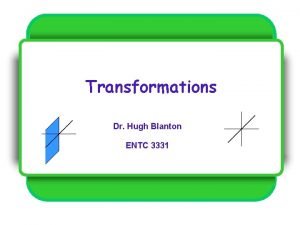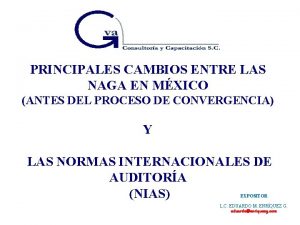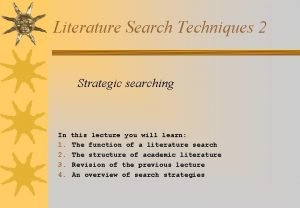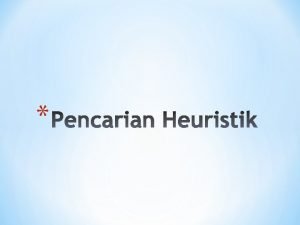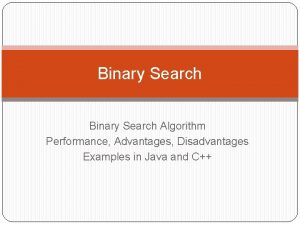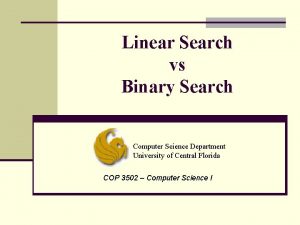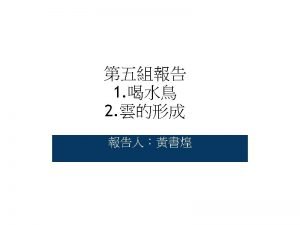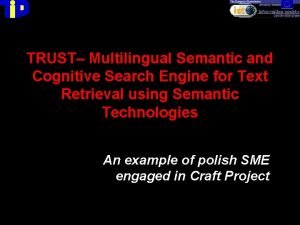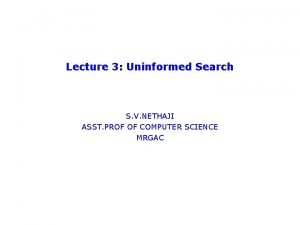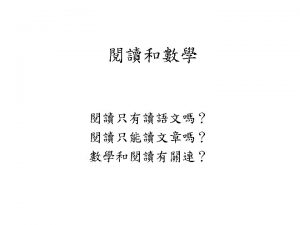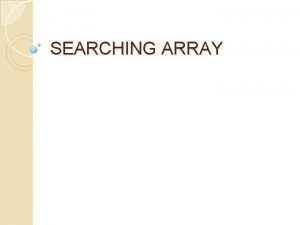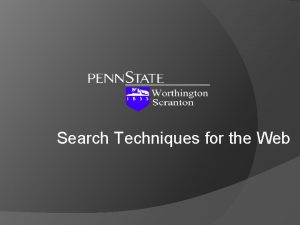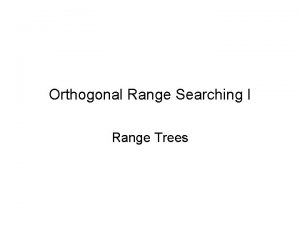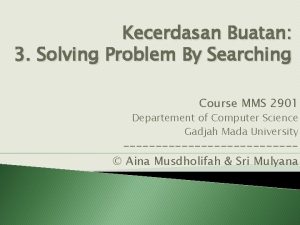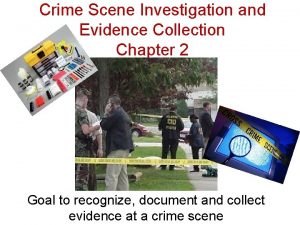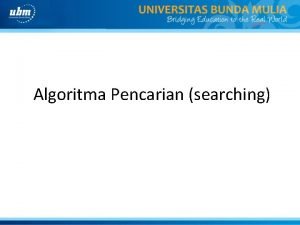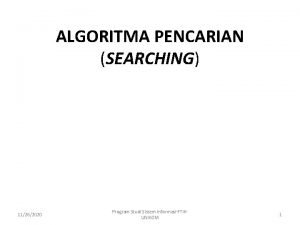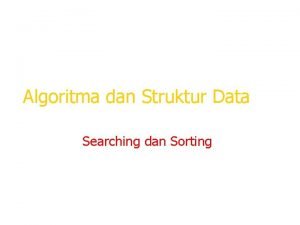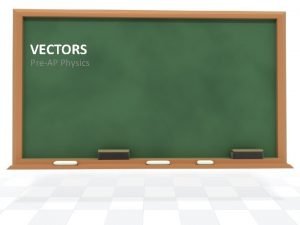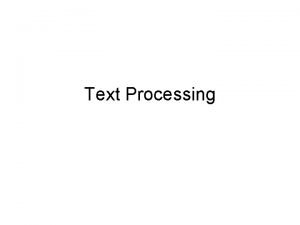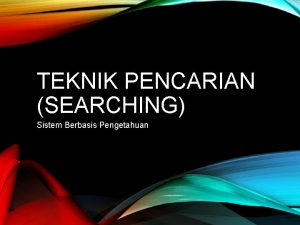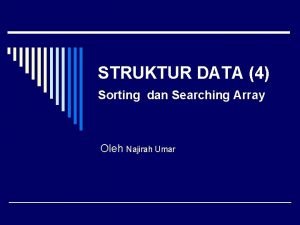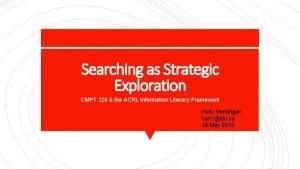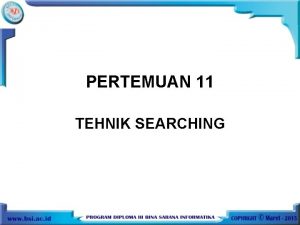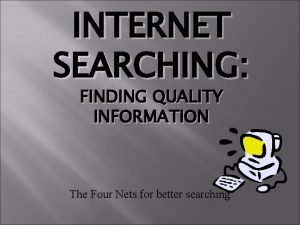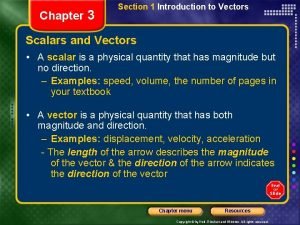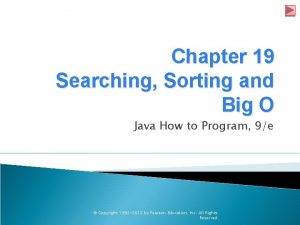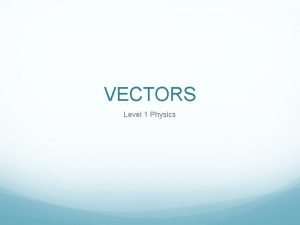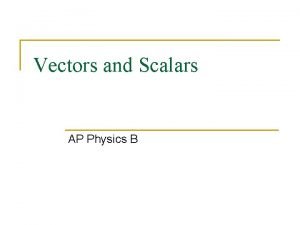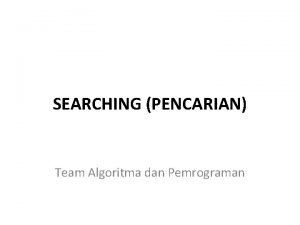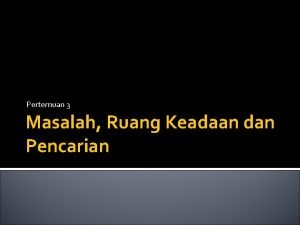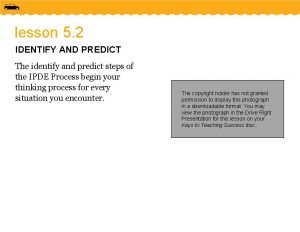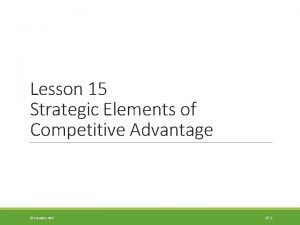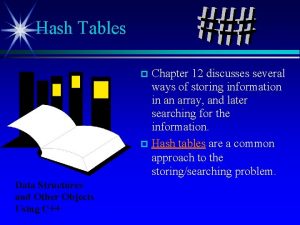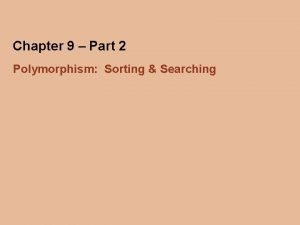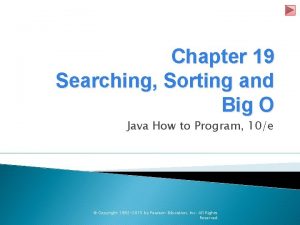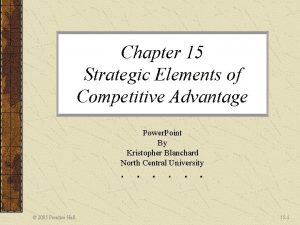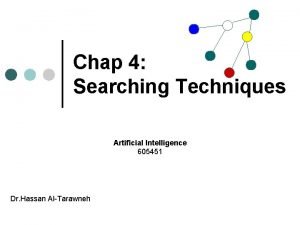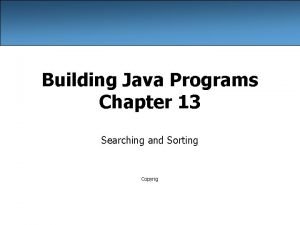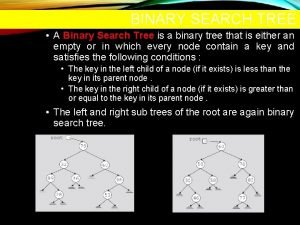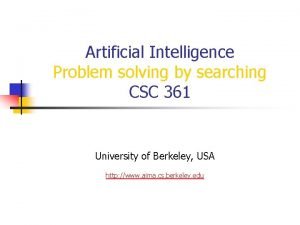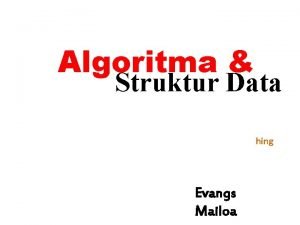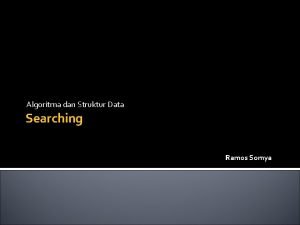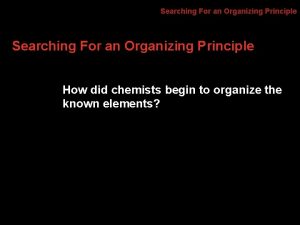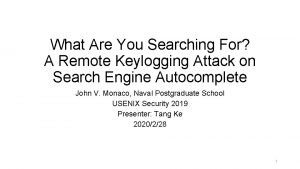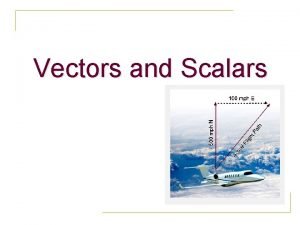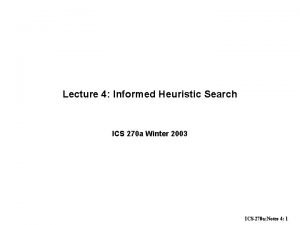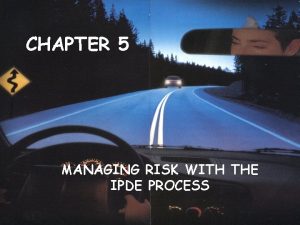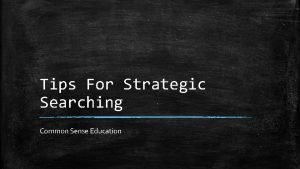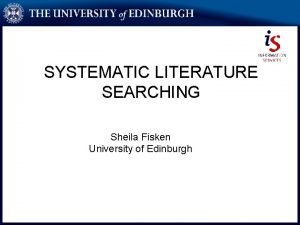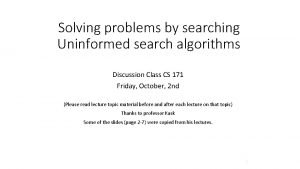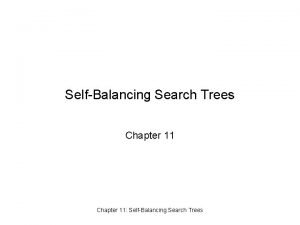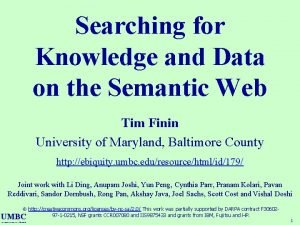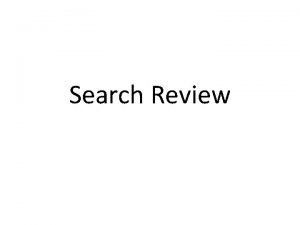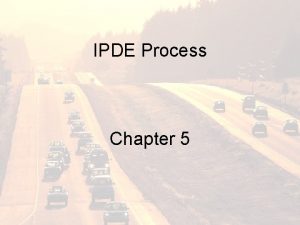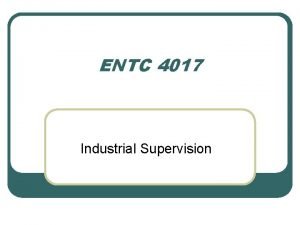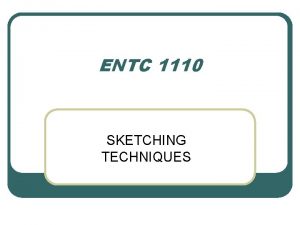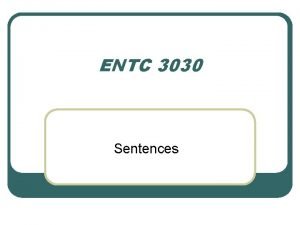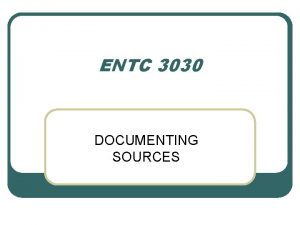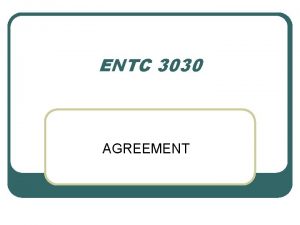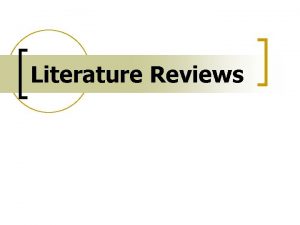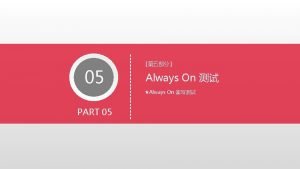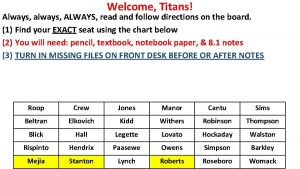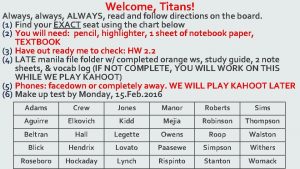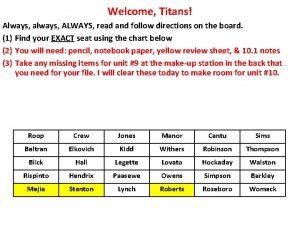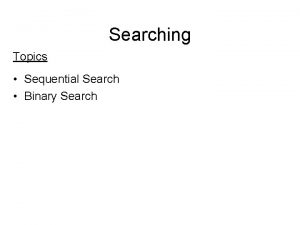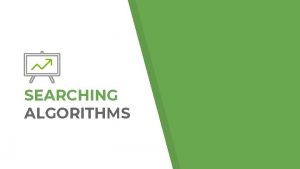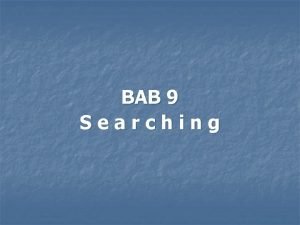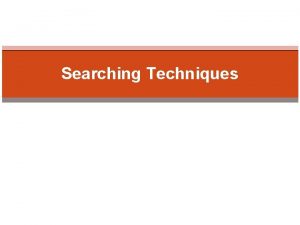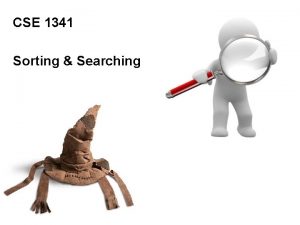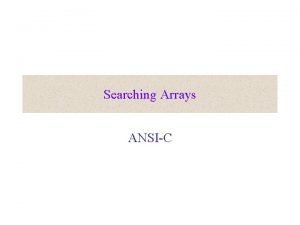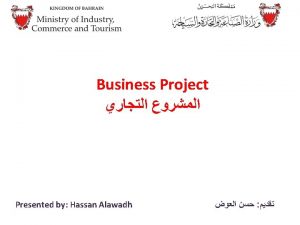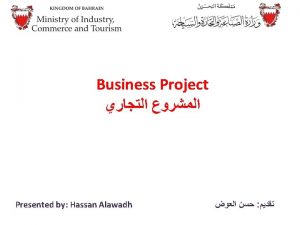ENTC 3030 LITERATURE SEARCH l Literature searching always









































































- Slides: 73

ENTC 3030 LITERATURE SEARCH

l Literature searching always involves a time trade-off. • Locating published information can support your research and may even streamline parts of your work.

The Flow of Technical Information l Searching the published record helps you • Locate reference information necessary for • • • routine research Gather data to extend your methods, findings, and discussions Follow the broad trends in your field and identify promising research problems Follow theoretical, empirical, methodological, and design work of related fields

l Remember that information in print is old data. • More current information flows orally among colleagues in a laboratory, passing through small in-house seminars and sometimes becoming bottled in proposals, progress reports, and memos, most of which are proprietary.

l In pure research, information moves outside the organization into various forums: • conference proceedings, • formal reports, and • refereed articles.

l Moving from project initiation to journal publication takes up to five years. • • l Four to eighteen months may pass as the manuscript goes through the review-editorial stage and emerges as a published article. Another month to a year may pass before the information is indexed and abstracted. Five more years may elapse before it is absorbed in reference works, including review articles and textbooks.

l You can intercept information at several stages— • • • in conversations, letters, seminars, colloquia, preliminary reports, theses, preprints, published reports, articles, literature guides, and reference works.

l Two factors vastly increase your ability to be current and concrete in your information searching: • • Access to an expert. The closer you get to the source of the expertise, the more current the information. Electronic data. On-line capabilities, both in local databases and on the World Wide Web, not only increase your reach, speed, and versatility in locating information but also give you access to information before it is in print. Increasingly, some materials appear only in electronic form.

The Reference Library l Libraries have three elements: • catalogs, • literature guides, and • collections, or stacks.

l Catalogs, now mostly on-line, list the holdings of a library; • They are your primary points of entry to what the library owns physically or has access to electronically.

l While catalogs list journals and other serial publications, they do not normally list individual journal articles, reports, or other short forms. • Short publications are indexed in literature guides for specific fields.


l No library, however, will contain every item listed in guides like Chemical Abstracts or Compendex (formerly known as the Engineering Index).

l Increasingly, catalogs, literature guides, and collections are incorporated in an electronically linked system. • • You enter the system from your workstation or personal computer, accessing either the on-line catalogs or the database of selected literature guides. From all these, you retrieve bibliographical entries and their call numbers (or URLs if for electronic access), which you then use to locate items of interest, either in hard copy in the library’s collections or through electronic access.

l The texts held in the library’s main collections may be hard copy, microform, electronic files, or compact disk technology (CD-ROM). • • CD-ROM storage increases space, with a single disk capable of storing up to 300, 000 pages of print. The current trend in information retrieval is toward the building of large-scale digital libraries that are accessed on the Internet.

l A typical on-line catalog entry for an author shows • Author-title-subject information • Publication and imprint information • Call number • Location and availability

l On-line capabilities improve the speed and facility of library access. • You can search through • authors, • titles, • subjects, • numbers (ISBNs, call numbers, government numbers, etc. ), and • keywords.

Finding Technical Literature l You locate different kinds of documents by consulting general or specialized listings, including the main catalog and standard reference works. • Consult reference librarians if you are unfamiliar with the guides that index the literature of your specialty.

Guides to the Literature l Literature guides list and abstract individual articles. • • These guides are indexed in the main catalog by title and corporate author (sponsoring organization). More than 2, 000 abstracts journals cover the annual research output of the sciences and applied sciences. These literature guides are listed in various reference works, including C. D. Hurt’s Information Sources in Science and Technology (1998), which arranges bibliographies and literature guides by field.

l Abstracts journals and databases cover mostly articles and reports but also include patents, theses, proceedings, and books. • If your library subscribes to the electronic version of a literature guide like Chemical Abstracts or a database like MEDLINE, you can search it electronically— possibly on the Web from your office computer.

Journals l Professional journals are usually listed in the main catalog, which identifies their location and call numbers. • • Some libraries, especially those without on-line main catalogs, may list journals and other serial publications in a Periodicals Checklist located in a fiche tile in the library’s reference section. Many libraries maintain an on-line periodicals checklist, as well as an on-line listing linked to the electronic journals the library carries.

l When you find an article listing in a literature guide, you then go to the main catalog or periodicals checklist to find the journal location, usually alphabetically by title, and call number.

Books, Monographs, Proceedings, and Review Series l Books of all kinds are listed in the main catalog under authors or editors, title, subjects, and corporate authors. • • • Locating conference proceedings requires the conference title and date. If you need these, consult the librarian. Proceedings are also listed in the Institute for Scientific Information’s (ISI) Index to Scientific and Technical Proceedings and in other literature guides such as COMPENDEX. Review series (e. g. , Advances in Bioengineering) are listed under the series title.

Reports l Some reports are listed in the main catalog under author, corporate author, title, subject, or number. • These entries, however, represent only a • fraction of the report literature in a technical library. Normally, libraries maintain a separate reports checklist, either in hard copy or on-line, alphanumerically arranged by report number or government number.

l First, you locate a report and its number in a literature guide or database such as NTIS or the NASA Technical Report Server ((www. sti. nasa. gov. casitrs. html>). • Then you identify its location by finding the report number in your library’s reports checklist, identifying an outside vendor, or locating the report on a Webbased reports server.

Dissertations l In academic libraries, dissertations written at the same institution are indexed in the main catalog under author and title. • Other dissertations in science and applied science appear in the Dissertation Abstracts International, B, The Sciences and Engineering. • This reference work is usually available in the reference section of your library on CD-ROM, or on a Web link as the searchable database Dissertation Abstracts Online.

Standards and Patents l l The vast literature of standards and patents is too diffusely distributed for all but a highly specialized library. • Consult the reference librarian. • ISI’s Derwent Innovations Index is an electronically searchable citation and subject index for worldwide patent literature in the sciences and engineering. Indexes to the patent and standards literature are often listed in the main catalog under subject headings like “Patents” and “Standards. ”

l l Two additional resources are the U. S. Patent and Trademark Office at <www. uspto. gov>, which contains a list of regional depository libraries and a searchable patent database, and the Delphion Intellectual Property Network at (www. delphion. com/ibm. html> for access to the full-text and images of U. S. , European, and Japanese Patents since 1974. To locate international standards literature from sector standards organizations, government agencies, and international standards organizations, contact the American National Standards Institute’s NSSN database at <www. nssn. org>.

Electronic Journals, Bulletins, and Discussion Lists l Electronic journals and discussion lists are proliferating. • • • Electronic journals have become a major means of refereeing and disseminating research results. Many important journals like Science of the American Association for the Advancement of Science are now delivered in both hard copy and electronic formats and may be available on your local library network. Network bulletin boards and discussion lists provide access to ongoing technical discussions, conference announcements, job lists, news in the profession, software, language groups, and so on.

Conducting Your Search l Your search strategy depends on your task. • Always plan your search before you commit a lot of time to the process. • If the search is not routine, you can save time and avoid becoming bogged down by consulting a research librarian and running a for-fee professional search.

Determining Your Information Needs l l l Ask yourself what aspects of your problem might be explained in the published record. Think carefully about what you want to accomplish. You can spend hours flipping through catalog cards or wandering around electronic databases, hoping to find a useful listing.

l Much— maybe most—information will come to you from colleagues and by word of mouth.

l You can add to this information by focusing your search on a specific goal, like one of the following: • • • Bibliography search. To fill our a citation or check its accuracy Location search. To retrieve a published item Subject or concept search. To isolate a class of information by using subject headings and keywords Methodology search. To find information about processes invented and refined by others Follow-up search. To trace developments in theory, applications, or results of a field Specific question search. To find an answer to a specific question

• • • State-of the-art search. To identify the most recent advances in theory or applications for a specific concept or process Multidisciplinary search. To concentrate information from sources across disparate fields Comprehensive bibliography search. To compile with the help of one or more databases an exhaustive list of sources treating a specific topic World Wide Web search. To search for information on the Internet using a Web search engine such as Alta. Vista, Google, or Yahoo!

l A search can produce a single item on a computer screen or a massive listing of hundreds of items. • If you are new to a field, you may need to read background literature so that you can talk intelligently about a topic. Start with broad sources and progress toward more specialized works.

1. Dictionaries, encyclopedias 2. Textbooks, general books, monographs 3. Abstracts and index journals, databases, review articles, bibliographies 4. Electronic journals, journal articles, reports, letters

Focusing the Subject Matter l Your search needs a focused question. • • For example, the question • “How good is the available underwater connector technology? ” will produce’ more useful references if you rephrase it to ask • “What was published on performance and reliability for • • underwater electrical connectors in 1992— 2002? ” The word “good” is now expressed as “performance” and reliability, ” two key terms widely used in the field. “Underwater connector” is qualified by “electrical. ” • The rephrased question also establishes time limits.

l The less abstract and open-ended the question, the more likely you’ll get concrete references. • You can thus focus a search by refining your terms. • If you are uncertain of the key terms for a topic, consult one of three widely used thesaurus for science and engineering: • • • Thesaurus of Engineering and Scientific Terms (Inspec 1995), Library of Congress Subject Headings (1975—), or The Engineering Information Thesaurus (1992—) of the Engineering Index.

l Limit your search by considering the following: • • • Subject: Sources: Time: Authors: Institutions: Documents: Key terms and subject headings Key publications, literature guides, or series. Inclusive dates for acceptable publications. Specific authors or corporate sponsors of interest Publications by individuals at key institutions Specific kinds of documents (e. g. , patents, standards, reports)

Developing Your Search Strategy l Searching for a specific publication is much easier than searching for general information. • A specific publication requires you to locate a • printed object. A general search requires you to concentrate information.

l When you have determined what you are looking for, you may decide just to glance at the indexes of a few relevant journals. • You may also decide to pursue a more systematic strategy through literature guides and databases.

Subject Searching l Subject searching means using subject headings or keywords to trace documents. • With keywords, you can search either titles or subject areas. • You identify keywords in books, articles, or thesaurus. • You then search the database, on-line catalog, or card catalog.

l Subject searches can be useful when you don’t know much about the subject or when you just want to browse. • Subject searching is also an excellent crossdisciplinary approach because the crossreferences often show topical relationships between materials you don’t normally associate.

l In the sciences and applied sciences, however, the number of terms is so vast and expands at such a rapid rate that you need to use thesaurus if you want to be accurate.

l In spite of its comfortable, encyclopedialike feel, subject searching is often not the best technique. • It’s slow, even on-line, and it often produces barren lists of documents with little relevance to your interests. • Subject searching on a Web browser can produce thousands of listings.

Snowball Searching l The most widely used searching technique, the “snowball approach, ” begins with a recent publication. • You find a key paper, preprint, review article, • or textbook. Then you look up items listed in the bibliography.

l From those retrieved items, you look up further entries. • The snowball search is fast and requires little use of literature guides.

l This technique does, however, have limitations. • It tends to move you back to literature that is obsolete, and if you begin with a marginal article, you can spend much time assembling a network of similarly marginal papers.

Citation Searching l In a citation search, you begin with a key source paper and compile a list of papers citing that paper. • The basis of your search is that papers citing • the source will be related. Just as the snowball search moves you backward, the citation search brings you forward because the papers citing are more recent than the paper cited.

l The crucial literature guide for citation searching is the Science Citation Index (SCI) of the ISI. • It is available in bard copy, on-line (The Web of Science), and on CD-ROM.

l The SCI consists of a citation index that lists the authors cited in footnotes and bibliographies of selected journals and books and a source index that lists authors of all citing publications. • Covering a core of more than 5, 700 journals, the SCI manages to account for a considerable percentage of the articles cited in basic science and applied science.

l Citation searching offers distinct advantages. • Like the snowball method, the citation search • moves directly from document to document, with no intervening terminology or subject indexes. But the journals it covers are only part of the published literature.

l Citation searching has limited applications to engineering, private sector science, and foreign publication.

Star Searching l With the star approach to searching, you look at certain star journals, researchers, or institutions that often account for a high proportion of the important publications and know-how in a specialized area. • If you monitor their output, you will find critical work done in a given field. • This approach offers focus.

l To follow key journals, go to back issues, skim the article titles and abstracts, and glance over the cumulative subject indexes. l To follow key authors, turn to the cumulative author indexes of journals or literature guides. • You can also follow the research output of a facility known for its special work.

Comprehensive Database Searching l You can carry out comprehensive database searches from a computer linked to one or more commercial database systems. • You focus the search by using thesauri to develop a search profile of terms that will draw the desired information from the database.

l The operation may require the assistance of a reference librarian and may be conducted most effectively on a fee-for-service basis with the help of an information specialist.

l Normally, the initial search profile needs to be tried out and focused until relevant titles and abstracts show on the screen. • Add terms to narrow the search. • Delete terms to broaden it.

l Database searching is useful when you • Need to compile a bibliography, • Gain access to restricted databases, or • Find recent bibliographical information before it appears in literature guides. • The sheer time required to read and assess the results of this kind of search, however, can be significant.

Running the Search l l Searches rarely go according to plan, so you need to combine planning with initiative. You might begin, for example, • • • with one or two papers furnished by a colleague, retrieve selected references listed in those papers, and then refer to a literature guide that indexes journals in which the most interesting papers appear.

l The key terms in the literature guide may help you modify your own list of keywords. • If you find a valuable author, you might look in the literature guide’s author index to see what else that author has published.

l Examine the corporate index to see if the author’s research group is producing other papers on the subject. • You might also glance at the SCI to see what other publications have cited your key papers.

l When you have compiled a list of potential papers, you need to retieve them. • This process can be time consuming.

l Examine the abstracts of the papers carefully to see if you really need the complete work. • Papers on topics close to your own research may be especially important if you’re in danger of duplicating the research of others.

l Photocopy and collect important papers. • Note other references of limited interest. • Keep your notes up to date.

Current Awareness Searching l Because advances and innovation are the lifeblood of scientific professions, staying informed is critical. • The best way is through routine, formal oral exchanges with colleagues, as well as peer group discussions at professional and trade conferences.

l Formal current awareness searching, by contrast, can keep you abreast of developments outside your circle of acquaintances. • It also requires special literature guides.

l One simple but useful tool is the contents journal, which prints the contents pages of recent professional journals. • Current Contents, a series of small biweekly contents journals published in hardcopy and electronic formats by the ISI comes in different specialized fields.

l A related service is the published search. • Many information vendors publish prepared searches, each based on a set of keywords that identifies specific subjects of interest. • These bibliographies may be ordered directly from the vendor.

Information Vendors l Information is now a commodity, and big information vendors offer a variety of services. • The most specialized (and expensive) are the Selective Dissemination of Information (SDI) services, which tailor searches to the individual purchaser.

l SDI services, offered by most information vendors, periodically match a database to search keywords provided by the purchaser. • The results are mailed or transmitted • electronically. These services are also available for new patents, government standards, and military specifications.

l Available services include • Published reference works such as abstracts • • • and index journals, bibliographies, and other compilations Current-awareness services, including contents journals and SDI services General and specialized databases available for on-line searching Document-on-demand acquisition services by e-mail, telephone, and mail

l Each vendor supplies literature and maintains a Web site that outlines specific services.
 Entc
Entc Nagas en méxico
Nagas en méxico Nasd rule 3030
Nasd rule 3030 Literature searching techniques
Literature searching techniques Low prices always
Low prices always Uninformed search
Uninformed search Federated search vs discovery
Federated search vs discovery Local search vs global search
Local search vs global search Federated search vs distributed search
Federated search vs distributed search What is informed search and uninformed search
What is informed search and uninformed search Images.search.yahoo.com
Images.search.yahoo.com Best first search in ai
Best first search in ai Heuristik
Heuristik Yahoo gravity
Yahoo gravity Video.search.yahoo.com
Video.search.yahoo.com Binary search advantage and disadvantage
Binary search advantage and disadvantage Search by image
Search by image Yahoo shopping tw
Yahoo shopping tw Cognitive search engine
Cognitive search engine Comparison of uninformed search strategies
Comparison of uninformed search strategies 1http
1http Sequential searching in information retrieval
Sequential searching in information retrieval Searching for solutions in artificial intelligence
Searching for solutions in artificial intelligence Pencarian elemen dalam array disebut juga dengan
Pencarian elemen dalam array disebut juga dengan Internet search techniques
Internet search techniques Orthogonal range searching
Orthogonal range searching Solving problem by searching
Solving problem by searching While the csi team is searching the crime scene, _____.
While the csi team is searching the crime scene, _____. Apa itu algoritma pencarian
Apa itu algoritma pencarian Kelemahan dari metode sequential
Kelemahan dari metode sequential Sorting dan searching
Sorting dan searching A storm system moves 5000 km due east
A storm system moves 5000 km due east Knuth morris pratt pattern matching algorithm
Knuth morris pratt pattern matching algorithm Teknik searching adalah
Teknik searching adalah Pengertian searching dalam struktur data
Pengertian searching dalam struktur data Searching for a star
Searching for a star Cmpt 320
Cmpt 320 Untuk menyelesaikan pencarian max dan min pada worst case
Untuk menyelesaikan pencarian max dan min pada worst case List the 4 nets for better internet searching
List the 4 nets for better internet searching Searching and sorting arrays in c++
Searching and sorting arrays in c++ A bear searching for food wanders 35 meters east
A bear searching for food wanders 35 meters east Big o java
Big o java Artificial intelligence chapter 3
Artificial intelligence chapter 3 Collinear vectors example
Collinear vectors example A storm system moves 5000 km due east
A storm system moves 5000 km due east Metode searching
Metode searching Masalah ruang keadaan dan pencarian
Masalah ruang keadaan dan pencarian Ocr gcse computer science algorithm questions
Ocr gcse computer science algorithm questions Why is it important to predict as you drive
Why is it important to predict as you drive Searching for loose bricks
Searching for loose bricks Searching for you
Searching for you Searching and sorting in java
Searching and sorting in java Searching and sorting java
Searching and sorting java Searching for loose bricks
Searching for loose bricks Searching techniques in artificial intelligence
Searching techniques in artificial intelligence Searching and sorting in java
Searching and sorting in java Searching
Searching Problem solving by searching in artificial intelligence
Problem solving by searching in artificial intelligence Evangs mailoa
Evangs mailoa Struktur data searching
Struktur data searching How did mendeleev organize his periodic table
How did mendeleev organize his periodic table What are you searching for?
What are you searching for? Vector components
Vector components A bear searching for food wanders 35 meters east
A bear searching for food wanders 35 meters east Searching 270
Searching 270 Tsia tsia searching for connection
Tsia tsia searching for connection Chapter 5 managing risk with the ipde process
Chapter 5 managing risk with the ipde process Strategic searching
Strategic searching Searching for sheila
Searching for sheila Uninformed search
Uninformed search Picture searching
Picture searching Searching for knowledge
Searching for knowledge Wexford planning search
Wexford planning search The ipde process encourages:
The ipde process encourages:
